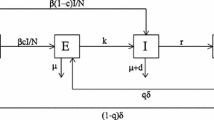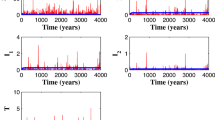Abstract
This work examines the global stability of the disease equilibria of three tuberculosis mathematical models that considered the effect of case detection vis a vis the implementation of the direct observation therapy strategy, factors that enhances the case detection rate and effect of heterogeneity in susceptibility and disease progression. Both linear and non-linear Lyapunov functions are constructed and used to show that the disease-free equilibrium is globally asymptotically stable when the corresponding effective reproduction number is less than or equal to one. However, under some special cases where the disease-induced death is insignificant, the endemic equilibrium is globally asymptotically stable when the effective reproduction number is greater than one.



Similar content being viewed by others
References
Beretta, E., Takeuchi, Y.: Global stability of Lotka-Volterra diffusion models with continuous time delay. SIAM J. Appl. Math. 48(3), 627–651 (1988)
Borgdorff, M.W.: New measurable indicator for tuberculosis case detection. Emerg. Infect. Dis. 10(9), 1523–1528 (2004)
Borgdorff, M.W., Floyd, K., Broekmans, J.F.: Interventions to reduce tuberculosis mortality and transmission in low and middle-income countries. Bull World Health Organ 80, 217–227 (2002)
Castillo-Chavez, C., Song, B.: Dynamical models of tuberculosis and their applications. Math. Biosci. Eng. 1(2), 361–404 (2004)
Korobeinikov, A.: Lyapunov functions and global properties for SEIR and SEIS epidemic models. Math. Med. Biol. 21, 75–83 (2004)
Korobeinikov, A., Maini, P.K.: A Lyapunov function and global properties for SIR and SEIR epidemiological models with nonlinear incidence. Math. Biosci. Eng. 1, 57–60 (2004)
Korobeinikov, A., Wake, G.C.: Lyapunov functions and global stability for SIR, SIRS, and SIS epidemiological models. Appl. Maths. Lett. 15, 955–960 (2002)
La Salle, J., Lefschetz, S.: The stability of dynamical systems. SIAM, Philadelphia (1976)
McCluskey, C.N.: Lyapunov functions for tuberculosis models with fast and slow progression. Math. Biosci. Eng. 3(4), 603–614 (2006)
Okuonghae, D.: A mathematical model of tuberculosis transmission with heterogeneity in disease susceptibility and progression under a treatment regime for infectious cases. Appl. Math. Model. 37, 6786–6808 (2013)
Okuonghae, D., Aihie, V.: Case detection and direct observation therapy strategy (DOTS) in Nigeria: its effect on TB dynamics. J. Biol. Syst. 16(1), 1–31 (2008)
Okuonghae, D., Korobeinikov, A.: Dynamics of tuberculosis: the effect of direct observation therapy strategy (DOTS) in Nigeria. Math. Model. Nat. Phenom. 2(1), 113–128 (2007)
Okuonghae, D., Omosigho, S.E.: Analysis of a mathematical model for tuberculosis: What could be done to increase case detection. J. Theor. Biol. 269, 31–45 (2011)
Song, B., Castillo-Chavez, C., Aparicio, J.P.: Tuberculosis models with fast and slow dynamics: the role of close and casual contacts. Math. Biosci. 180, 187–205 (2002)
Styblo, K., Bumgarner, J.R.: Tuberculosis can be controlled with existing technologies: evidence. The Hague: Tuberc. Surveill. Res. Unit 2, 60–72 (1991)
Takeuchi, Y.: Global dynamical properties of Lotka-Volterra systems. World Scientific, Singapore (1996)
van den Driessche, P., Watmough, J.: Reproduction numbers and sub-threshold endemic equilibria for compartmental models of disease transmission. Math. Biosci. 180, 29–48 (2002)
WHO.: Global tuberculosis control. WHO Report, Geneva (2013)
Author information
Authors and Affiliations
Corresponding author
Rights and permissions
About this article
Cite this article
Okuonghae, D. Lyapunov functions and global properties of some tuberculosis models. J. Appl. Math. Comput. 48, 421–439 (2015). https://doi.org/10.1007/s12190-014-0811-4
Received:
Published:
Issue Date:
DOI: https://doi.org/10.1007/s12190-014-0811-4




